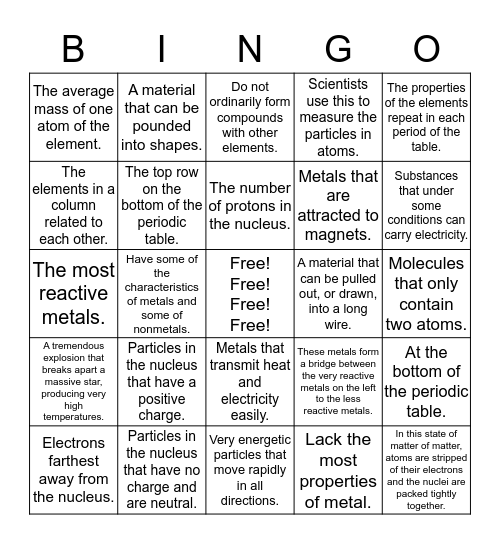

This bingo card has a free space and 24 words: Particles in the nucleus that have a positive charge., Particles in the nucleus that have no charge and are neutral., The number of protons in the nucleus., Electrons farthest away from the nucleus., The properties of the elements repeat in each period of the table., The average mass of one atom of the element., The elements in a column related to each other., A material that can be pounded into shapes., A material that can be pulled out, or drawn, into a long wire., Metals that transmit heat and electricity easily., Metals that are attracted to magnets., The most reactive metals., These metals form a bridge between the very reactive metals on the left to the less reactive metals., At the bottom of the periodic table., The top row on the bottom of the periodic table., Lack the most properties of metal., Molecules that only contain two atoms., Do not ordinarily form compounds with other elements., Substances that under some conditions can carry electricity., Have some of the characteristics of metals and some of nonmetals., In this state of matter of matter, atoms are stripped of their electrons and the nuclei are packed tightly together., A tremendous explosion that breaks apart a massive star, producing very high temperatures., Scientists use this to measure the particles in atoms. and Very energetic particles that move rapidly in all directions..
Ch. 3 Science vocab | SCIENCE 3 VOCAB | Structure of Matter - Atoms, Elements, Per. Table | Unit 1: Matter | SC.8.P.8.5/SC.8.P.8.6 (Elements, Compounds, and the Periodic Table)
Share this URL with your players:
For more control of your online game, create a clone of this card first.
Learn how to conduct a bingo game.
With players vying for a you'll have to call about __ items before someone wins. There's a __% chance that a lucky player would win after calling __ items.
Tip: If you want your game to last longer (on average), add more unique words/images to it.